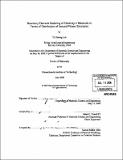Boundary element modeling of elasticity in materials in terms of distribution of second phase structures
Author(s)
Lok, Yi Cheung
DownloadFull printable version (23.54Mb)
Other Contributors
Massachusetts Institute of Technology. Dept. of Materials Science and Engineering.
Advisor
Adam C. Powell, IV.
Terms of use
Metadata
Show full item recordAbstract
The Boundary Element Method is used to study the interaction of second phase objects in a material. In particular, this study examines the relationship between stress parameters, such as stress concentration and normal traction, and geometrical parameters such as separation distance and orientation. The use of BEM enables easy manipulation of internal objects and rapid re-calculation in a series of simulations. Additional library functions are added to Julian, a general BEM solver, to expand its functionality to include elasticity calculation, inclusion modeling, and shape optimization with parallel processing. With a few thousand nodes, it is found that computation time scales as O(V), where N is the resolution of the mesh in each direction. An accuracy of over 99% is achieved in many benchmarks. A spherical cavity next to an inclusion is found to have higher stress concentration when aligned parallel to the loading direction. Stress analysis on a pair of neighboring cavities shows relatively small (less than 10%) increase in stress concentration beyond a separation of 0.5 diameter. (cont.) While highest stress is observed when two cavities are aligned perpendicular to loading direction at very close separation, the highest stress configuration deviates from that alignment to almost +/- 30 degrees as separation increases. The radius of interaction is found to be determined by the larger of two second phase objects and is larger for a cavity surrounded by eight cavities in three dimensions. Our result suggests that a 15% weight saving is possible in a closed-cell foam for less than 10% increase in stress concentration due to the presence of immediate neighbors.
Description
Thesis (Ph. D.)--Massachusetts Institute of Technology, Dept. of Materials Science and Engineering, 2006. Includes bibliographical references (p. 112-113).
Date issued
2006Department
Massachusetts Institute of Technology. Department of Materials Science and EngineeringPublisher
Massachusetts Institute of Technology
Keywords
Materials Science and Engineering.